This article relies largely or entirely on a single source .(May 2015) |
Engschrift is a condensed or "narrow" (German : eng) form of the DIN 1451 standard typeface. It is used in a modified form for road signage in Austria.
This article relies largely or entirely on a single source .(May 2015) |
Engschrift is a condensed or "narrow" (German : eng) form of the DIN 1451 standard typeface. It is used in a modified form for road signage in Austria.
This section may be confusing or unclear to readers.(November 2017) |




Austria uses the transformed font from the German counterpart DIN 1451 Engschrift font. Scripture is officially used as the standard font for traffic signs in Austria. Since 2010 text Tern is used, which dates back to the EU regulations. But for the most part is used in place names in Austria - as well as the previous font Engschrift was specifically designed. Because the existing road signs are replaced prematurely, Austria will continue to use the base font on all roads . New font that should be used throughout the EU, the font Schrift "Tern", according to experts, the test is easier to read and thus prevent accidents.
New road signs font Tern is a result of the EU project, which was developed policy of uniform road signs in Europe. The project was funded by the Austrian Fund for road safety. Tern has been proven in many tests and readability decreased in comparison with the other fonts used in Europe as the winner. Danube University Krems has made a test lab with 98 vehicle operators. This font has been verified as the best 20 languages (including Greek). Although the EU directive should not be missed in the Austrian Extra solutions. Due to the length of names (example: "Sierninghofen"), a private Schrift Engschrift was on these long names developed.
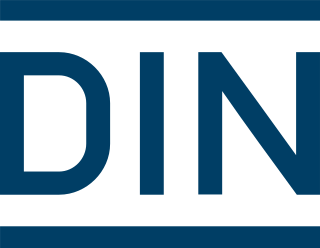
Deutsches Institut für Normung e.V. is the German national organization for standardization and is the German ISO member body. DIN is a German Registered Association (e.V.) headquartered in Berlin. There are currently around thirty thousand DIN Standards, covering nearly every field of technology.

Helvetica, also known by its original name Neue Haas Grotesk, is a widely used sans-serif typeface developed in 1957 by Swiss typeface designer Max Miedinger and Eduard Hoffmann.

Frutiger is a series of typefaces named after its Swiss designer, Adrian Frutiger. Frutiger is a humanist sans-serif typeface, intended to be clear and highly legible at a distance or at small text sizes. A popular design worldwide, type designer Steve Matteson described its structure as "the best choice for legibility in pretty much any situation" at small text sizes, while Erik Spiekermann named it as "the best general typeface ever".

Adrian Johann Frutiger was a Swiss typeface designer who influenced the direction of type design in the second half of the 20th century. His career spanned the hot metal, phototypesetting and digital typesetting eras. Until his death, he lived in Bremgarten bei Bern.

Clearview, also known as Clearview Hwy, is the name of a humanist sans-serif typeface family for guide signs used on roads in the United States, Canada, Indonesia, the Philippines, Israel, Brazil and Sri Lanka. It was developed by independent researchers with the help of the Texas Transportation Institute and the Pennsylvania Transportation Institute, under the supervision of the Federal Highway Administration (FHWA). It was once expected to replace the FHWA typefaces in many applications, although newer studies of its effectiveness have called its benefits into question.
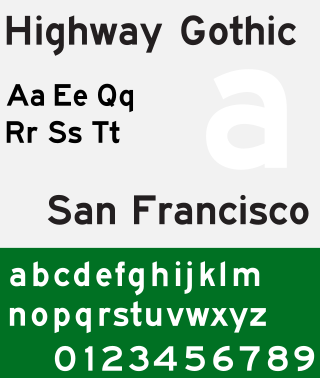
Highway Gothic is a sans-serif typeface developed by the United States Federal Highway Administration (FHWA) and used for road signage in the Americas, including the U.S., Canada, Latin America and some Caribbean countries, as well as in Asian countries influenced by American signage practices, including the Philippines, China, Taiwan, Malaysia, Indonesia and Thailand.

Rotis is a typeface developed in 1988 by Otl Aicher, a German graphic designer and typographer. In Rotis, Aicher explores an attempt at maximum legibility through a highly unified yet varied typeface family that ranges from full serif, glyphic, and sans-serif. The four basic Rotis variants are:
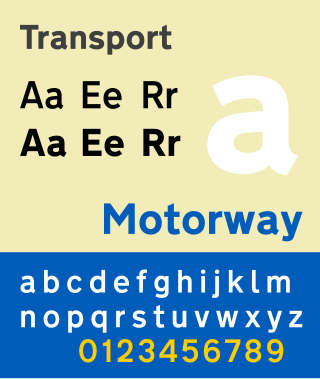
Transport is a sans serif typeface first designed for road signs in the United Kingdom. It was created between 1957 and 1963 by Jock Kinneir and Margaret Calvert as part of their work as designers for the Department of Transport's Anderson and Worboys committees.

DIN 1451 is a sans-serif typeface that is widely used for traffic, administrative and technical applications.

The FE-Schrift or Fälschungserschwerende Schrift is a sans serif typeface introduced for use on licence plates. Its monospaced letters and numbers are slightly disproportionate to prevent easy modification and to improve machine readability. The typeface was developed in Germany, where it has been mandatory since November 2000.
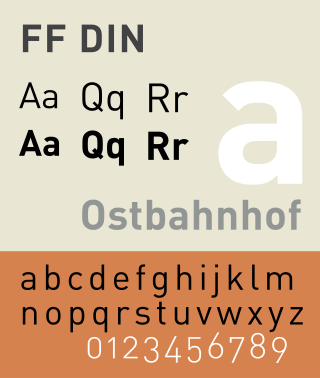
FF DIN is a sans-serif typeface in the industrial or "grotesque" style. It was designed in 1995 by Albert-Jan Pool, based on DIN-Mittelschrift and DIN-Engschrift, as defined in the German standard DIN 1451. DIN is an acronym for Deutsches Institut für Normung. It was published by FontShop in its FontFont library of typefaces.

Albert-Jan Pool is a Dutch type designer and educator.

Vehicle registration plates of Latvia consist of two letters, a hyphen and one to four numbers (depending on the age of registration), e.g., AB-1234,
The vehicle registration plates of Cyprus are composed of three letters and three digits. A simple incremental numbering system is used; numbers run from 001 to 999 per letter sequence (alphabetic), so that, for example, the plate to be issued after MAA 999 would be MAB 001. However, registrants may be allowed to choose a number from available numbers in the extant letter sequence.

European traffic signs present relevant differences between countries despite an apparent uniformity and standardisation. Most European countries refer to the 1968 Vienna Convention on Road Signs and Signals. The convention has been adopted by the following countries : Albania, Armenia, Austria, Belarus, Belgium, Bosnia and Herzegovina, Bulgaria, Croatia, Cyprus, the Czech Republic, Denmark, Estonia, Finland, France, Georgia, Germany, Greece, Hungary, Italy, Latvia, Liechtenstein, Lithuania, Luxembourg, Moldova, Montenegro, Netherlands, North Macedonia, Norway, Poland, Portugal, Romania, Russia, San Marino, Serbia, Slovakia, Slovenia, Spain, Sweden, Switzerland, Turkey, Ukraine and the United Kingdom. The convention has not been adopted by Ireland, Iceland or Malta.

Motorway is a sans-serif typeface designed by Jock Kinneir and Margaret Calvert for use on the motorway network of the United Kingdom. Motorway was first used on the M6 Preston bypass in 1958 and has been in use on the UK's motorways ever since. The typeface is also used in some other countries, most notably Ireland and Portugal.
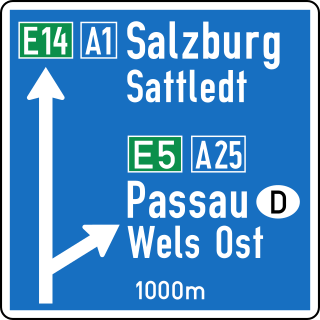
Austria was the typeface formerly used on all official road signage in Austria made prior to 2010. A modified version of its German counterpart DIN 1451, it came in narrow- and medium-width fonts. Since 2010 it has been replaced on all new road signs by the more recently developed Tern typeface.
This article is a summary of traffic signs used in each country.
Tern is a sans-serif typeface, which is used on traffic signs in Austria and Slovakia.